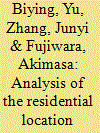|
|
|
Sort Order |
|
|
|
Items / Page
|
|
|
|
|
|
|
| Srl | Item |
| 1 |
ID:
112913


|
|
|
|
|
| Publication |
2012.
|
| Summary/Abstract |
It is expected that the residential location choice and household energy consumption behavior might correlate with each other. Besides, due to the existence of self-selection effects, the observed inter-relationship between them might be the spurious result of the fact that some unobserved variables are causing both. These concerns motivate us to (1) consider residential location choice and household energy consumption behavior (for both in-home appliances and out-of-home cars) simultaneously and, (2) explicitly control self-selection effects so as to capture a relatively true effect of land-use policy on household energy consumption behavior. An integrated model termed as joint mixed Multinomial Logit-Multiple Discrete-Continuous Extreme Value model is presented here to identify the sensitivity of household energy consumption to land use policy by considering multiple self-selection effects. The model results indicate that land-use policy do play a great role in changing Beijing residents' energy consumption pattern, while the self-selection effects cannot be ignored when evaluating the effect of land-use policy. Based on the policy scenario design, it is found that increasing recreational facilities and bus lines in the neighborhood can greatly promote household's energy-saving behavior. Additionally, the importance of "soft policy" and package policy is also emphasized in the context of Beijing.
|
|
|
|
|
|
|
|
|
|
|
|
|
|
|
|
| 2 |
ID:
121379


|
|
|
|
|
| Publication |
2013.
|
| Summary/Abstract |
This paper examines whether increases in energy efficiency of major household items cause additional short-run utilization of these end uses and other end uses for households in Beijing. An integrated model is first developed by combining a Logit model and a resource allocation model, where the former represents the choice of end-use ownership and the latter describes the end-use usage. The rebound effects are finally obtained from calculating the own- and cross-elasticities based on the prediction. The empirical results show that for refrigerators, electric fans, gas showers, TVs, and PCs, no evident rebound occurs; while for air conditioners, clothes washers, microwave ovens, and cars, either a direct rebound effect or an indirect rebound effect exists significantly. The respective average upper bound of direct rebound effects for them are 60.76%, 106.81%, 100.79%, and 33.61%, suggesting a possibility of backfire for the clothes washers and microwave ovens, while the respective upper bound of total rebound effects are 88.95%, 100.36%, 626.58%, and 31.61%. Furthermore, increasing the efficiency of air conditioners and cars can definitely reduce the total household energy consumption during the use phase.
|
|
|
|
|
|
|
|
|
|
|
|
|
|
|
|
| 3 |
ID:
107497


|
|
|
|
|
| Publication |
2011.
|
| Summary/Abstract |
It is expected that in-home and out-of-home energy consumption behavior in a household might be correlated with each other, probably due to the existence of household budget constraints. Ownership and usage of energy-saving technologies for in-home appliances (or vehicles) might lead to the increase in out-of-home (or in-home) energy consumption. It is therefore necessary to jointly represent in-home and out-of-home energy consumption in the same modeling framework. With this consideration, we first build a new type of energy consumption model based on the Multiple Discrete-Continuous Extreme Value (MDCEV) modeling framework. Next, we conducted a questionnaire survey in Beijing in 2009 and successfully collected the information about households' energy consumption, ownership/usage of in-home appliances and vehicles, and households' and their members' attributes from 1014 households. Throughout an empirical analysis, it is confirmed that the MDCEV model is effective to simultaneously describe the in-home and out-of-home energy consumption behavior. In addition, it is revealed that a set of household and personal attributes affect the ownership and usage of in-home appliances and vehicles. Furthermore, it is shown that the unobserved factors play a much more important role in explaining energy consumption behavior than the observed attributes of households and their members.
|
|
|
|
|
|
|
|
|
|
|
|
|
|
|
|
| 4 |
ID:
176649


|
|
|
|
|
| Summary/Abstract |
Understanding the energy use and choice behaviors in urban China is essential to curb its energy consumption and air pollutant emissions. Current energy consumption estimates for urban households in China rarely account for the effects of building types on energy choice behavior, thus may lead to biased policy implications. In this paper, we estimate the determinants of household energy consumption for different energy choice scenarios through the Seemingly Unrelated Regression (SUR) model, using urban household data. The empirical results show that household use of various energy carriers is driven by household income, fuel price, demographics, building attributes and lifestyles. Results show building types have a significant effect on household energy consumption behaviors. Households living in old houses have less access to clean energy, such as piped gas. Income and price elasticities of energy consumption vary with energy type in each scenario, and there exist certain substitution effects among different types of energy carriers. In particular, inter-fuel substitute elasticities between coal and clean energy are asymmetric. Our study highlights the significance of city planning and infrastructure expansion policies and also offers a better basis for coordinating and designing energy policies in urban China and other developing countries.
|
|
|
|
|
|
|
|
|
|
|
|
|
|
|
|
|
|
|
|
|